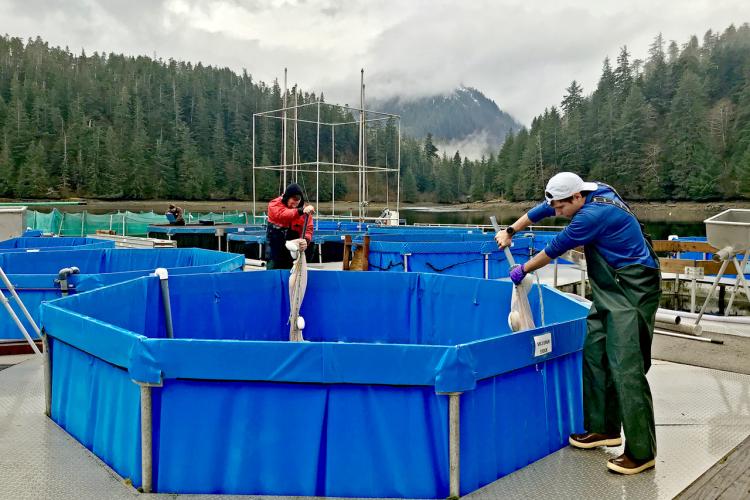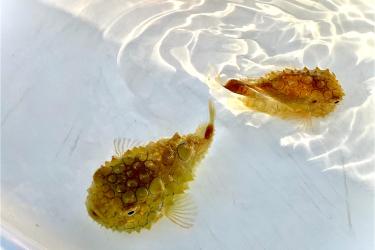Previously, I described the overall goal of our experiment – to quantify the effects of two common hatchery marking practices, coded-wire tagging and removing the adipose fin as an external mark, on the marine survival of Chinook salmon (see Post 2). But how do we actually mark the fish? Well, the suspense is over!
![1) Our 2019 LPW tagging crew (from left to right): Alexa Marinelli, John Eiler, Katlyn Fuentes, Gerard Foley, Mattea Berglund, and Debra Rose.]()
Our 2019 Little Port Walter tagging crew (from left to right): Alexa Marinelli, John Eiler, Katlyn Fuentes, Gerard Foley, Mattea Berglund, and Debra Rose.
The Necessities
Marking fish requires three things – a great crew of people, fun music, and some specialized equipment. To process 215,000 fish, we work in a small shed for 8 hours a day for 2.5 to 3 weeks, so things can get fairly monotonous. Additionally, our hands are in very cold water (3 to 6 degrees Celsius) all day. It REALLY helps to have a motivated crew and everyone’s favorite tunes to maintain a positive, fun atmosphere. This year at Little Port Walter, the tagging crew comprises myself, the station manager John Eiler, the resident culturist Gerard Foley, and contractors Mattea Berglund, Katlyn Fuentes, Alexa Marinelli, and Debra Rose. We also need a few specialized items: surgical scissors to clip the adipose fin, spools of coded-wire tags, a machine to cut individual tags and insert them into the fish, and a detector to verify that each fish has a tag.
![2) Our tagging setup. Fish are clipped in the green tank and sent down the water slides to the blue, cube-shaped machines, which cut individual tags and insert them into the fish. The fish are then passed through the blue, cylindrical detectors to verify that they have a tag.]()
Our tagging setup. Fish are clipped in the green tank and sent down the water slides to the blue, cube-shaped machines, which cut individual tags and insert them into the fish. The fish are then passed through the blue, cylindrical detectors to verify that they have a tag.
The Process
Now that we have our crew, our playlists, and the equipment, we can begin marking the fish for the experiment. First, we seine all the fish in a vertical raceway and transfer them to a holding tank inside the tagging shed using a series of connected pipes filled with running water. Once inside, small groups of fish are anesthetized, and their adipose fins are removed by our three clippers (John, Katlyn, and Mattea). After clipping, the fish are sent down miniature water slides to our two taggers (Alexa and Debra), who insert coded-wire tags into their noses using a specialized machine. They are then passed through a detector to verify that the tagging was successful. Once the fish have revived from the anesthesia, they are transferred to a large saltwater net pen. They will be held and monitored here for another month until they are released to begin their ocean migration.
It’s important to understand that not every fish receives a tag or has their adipose fins removed. We have three experimental groups (fish that are tagged and fin clipped, only tagged, and only fin clipped), which will allow us to see how the different types of marks affect marine survival. Nevertheless, our crew processes about 15,000 fish each day and has to handle every single fish. We’re gonna need a bigger playlist!





